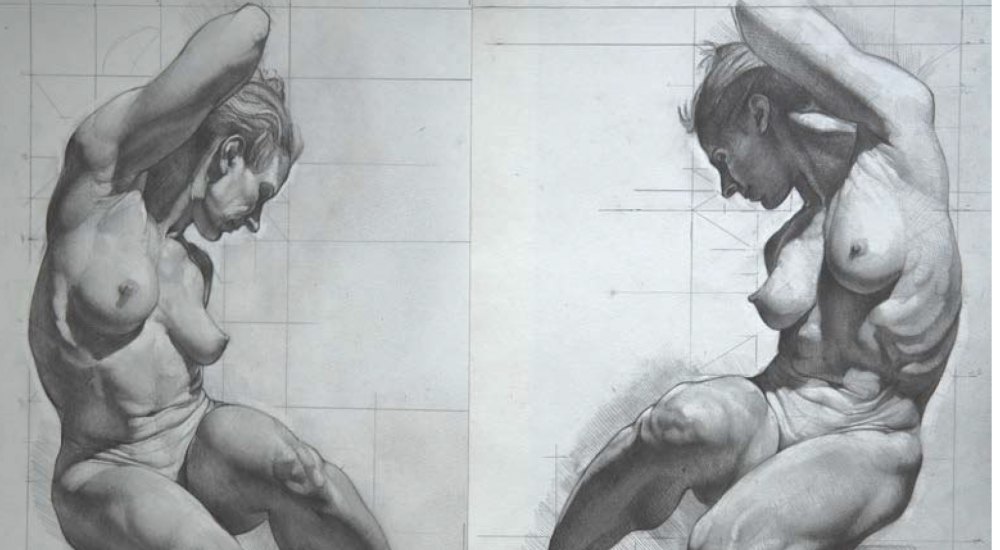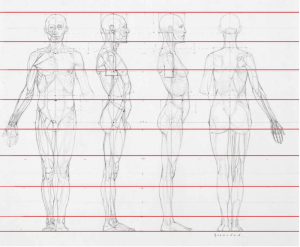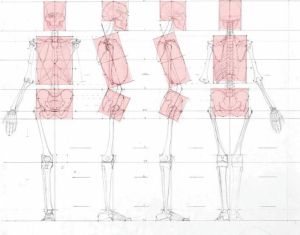Figurative Artist Handbook: Establishing The Basic Proportions

[vc_row][vc_column][vc_column_text]Drawing New York is thrilled to partner with artist Rob Zeller, author of The Figurative Artist’s Handbook to offer our members a ‘serialized digest’ of his extremely popular and beautiful book. Each week we will bring you new topics and techniques relating to figure drawing so check back often.[/vc_column_text][thb_gap height=”22″][vc_text_separator title=”Establishing The Basic Proportions” color=”sandy_brown”][/vc_column][/vc_row][vc_row][vc_column width=”2/3″][vc_column_text]It’s important to make sure, from the very start, that the various parts of the figure are to scale with one another. This is referred to as “keeping things in proportion.” You do not want to draw the head too large, the arms too long, the legs too short, and so forth. You want to be able to control the scale of your figure, so let’s discuss some strategies to do so.
The Head Length Method
Throughout the history of art, various canons of proportion have been popular at different times. Most involve a unit of measurement known as the head length— meaning, the figure is measured by how many head lengths tall it is, or how many head lengths wide it is, at any given point. Head length is an incredibly useful tool. I highly recommend it.

Noah Buchanan, 7 1⁄2 Head Proportional Écorche, 2014, graphite on paper, 18 x 24 inches – This proportional chart (with red lines added to show head units) displays a classically proportioned, 71⁄2– heads-high figure from various views.
Since the ancient Greeks, the standard proportions of the human figure, both male and female, vary between 71⁄2 and 8 heads high. By the nineteenth century, this was backed up by scientific data. I find the head length unit useful as a proportional tool at times, but I favor a method that is a little faster, and I think more effective, at capturing a given model’s specific proportions.[/vc_column_text][vc_column_text]
Tip: Some would argue that when first learning to draw the figure, you should aim for naturalism. Become a student of nature. Learn to draw the model as he or she really is. Later, your artistic vision should determine which proportional scale you use.
[/vc_column_text][thb_gap height=”22″][vc_column_text]The Block Concept
The head, rib cage, and pelvis make up the three biggest building blocks of the figure. The pelvis is more or less a horizontal rectangular solid, and the rib cage and head are vertical rectangular solids. Some argue that the head is more of a square than a rectangle. I’ve noticed that different people have differently shaped heads. The block concept is meant to be a tool, not dogma.

Noah Buchanan, 7 1⁄2 Head Proportional Skeleton, 2014, graphite on paper, 18 x 24 inches (45.7 x 60.9 cm) Noah Buchanan’s skeletal proportion chart for a 71⁄2–head-high figure also features the block concept—with the head, rib cage, and pelvis each fitting inside a block.
I use the term rectangular solids because these are three-dimensional shapes. When you draw them, know that each has a front, back, top, bottom, and two sides (like a regular box). While these building blocks are three-dimensional shapes, in the initial stages, it helps to see them as being flat, as shown in Noah Buchanan’s proportional chart.
Within each of these conceptual building blocks is a much more complicated mass, which we will study in depth later. The central column that holds these three boxes together is the spinal cord, which runs through each. Its base is the pelvis, and its apex is the head. Similar to the foundational supports that hold up a tall building, as goes the spine, so goes the figure.
There is a great deal more within this section of the book. Get your copy here.[/vc_column_text][/vc_column][vc_column width=”1/3″][vc_widget_sidebar sidebar_id=”home_1″][thb_gap height=”28″][vc_column_text]Top Image: Sabin Howard, Twins (Drawing for Sculpture), 2015, pencil, 22 x 24 inches[/vc_column_text][/vc_column][/vc_row][vc_row][vc_column][vc_column_text][ultimate_author_box user_id=”139″ template=’uab-template-12′][/vc_column_text][thb_gap height=”10″][/vc_column][/vc_row]


Responses